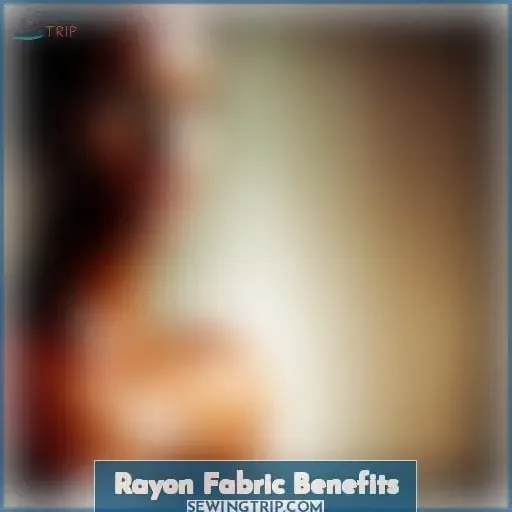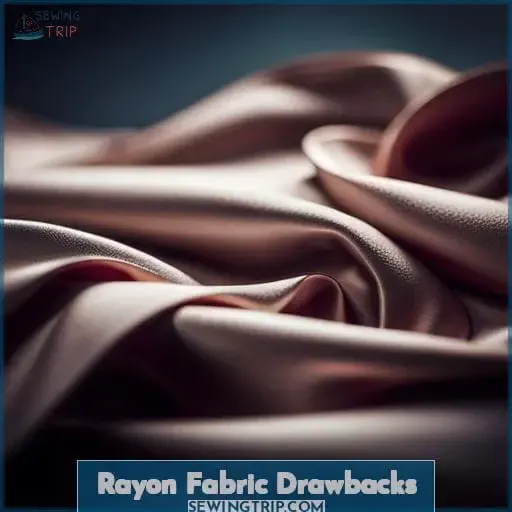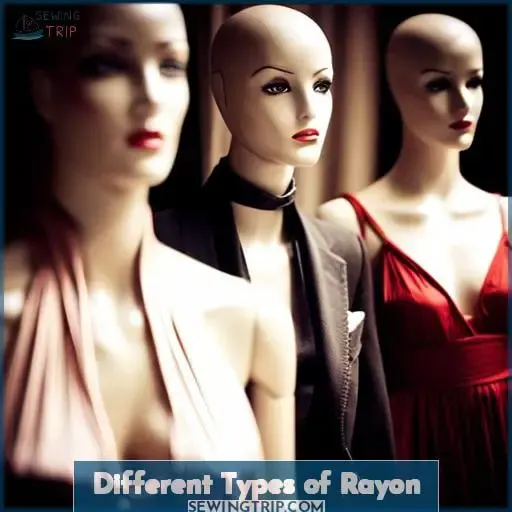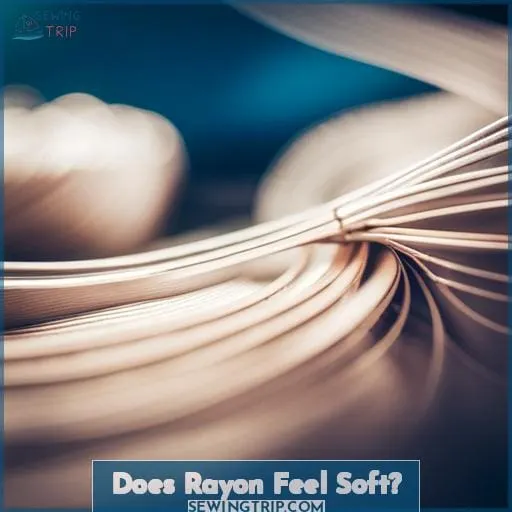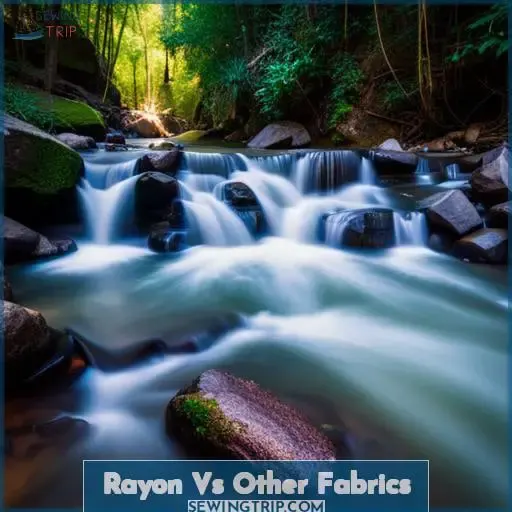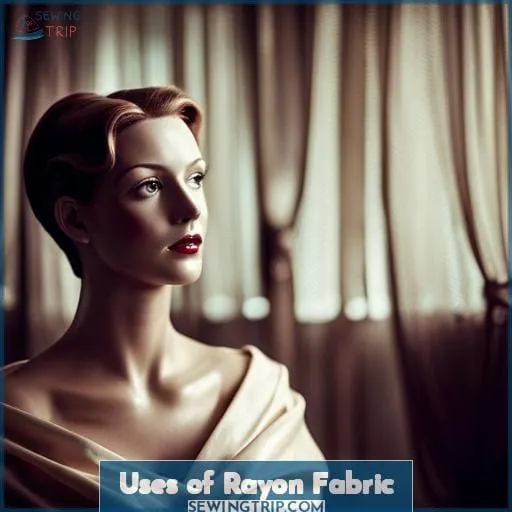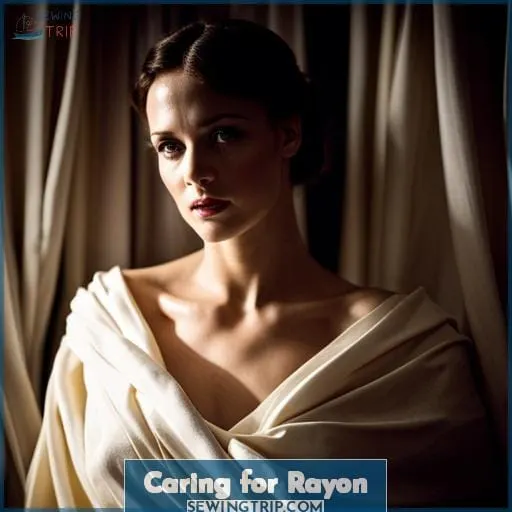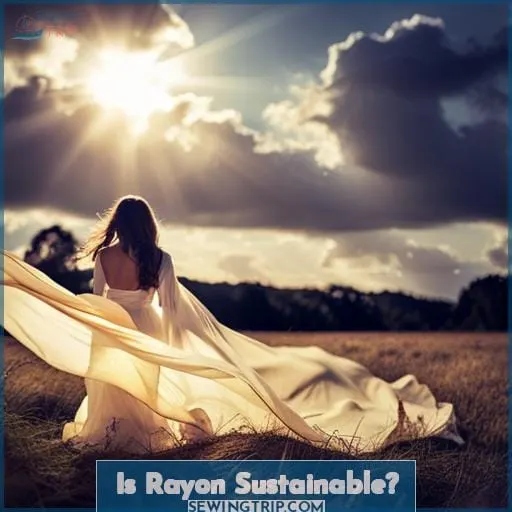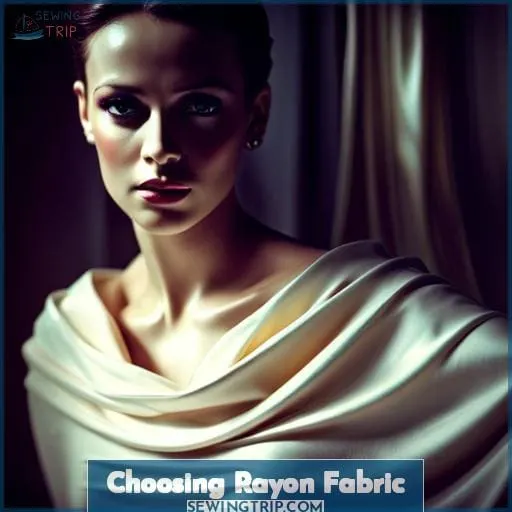This site is supported by our readers. We may earn a commission, at no cost to you, if you purchase through links.
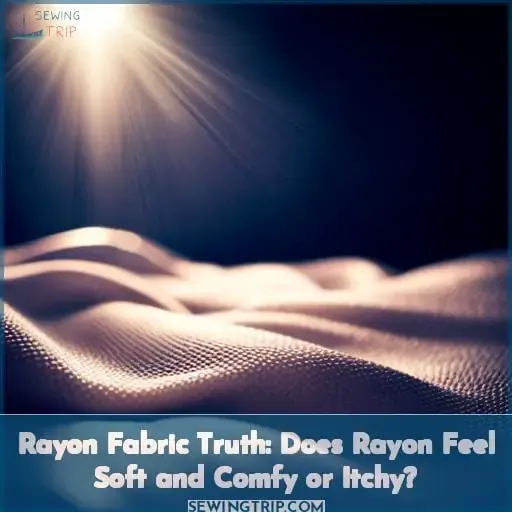 You’re like a mermaid here to seduce our senses with visions of effortless softness and fluid grace. Oh, rayon, your silky caresses conceal cunning secrets indeed. Let’s dive in and explore what makes this enticing fabric tick.
You’re like a mermaid here to seduce our senses with visions of effortless softness and fluid grace. Oh, rayon, your silky caresses conceal cunning secrets indeed. Let’s dive in and explore what makes this enticing fabric tick.
Seductress or siren – only a fuller exploration will reveal rayon’s true nature. Just like people, understanding comes from looking deeper beneath the surface at what lies within. Come, unveil rayon with me. Our journey promises rich revelations and a richer relationship with this complex and multifaceted textile.
Table Of Contents
Key Takeaways
- Rayon has a soft, smooth feel that mimics natural fabrics like silk and cotton.
- The different types of rayon like viscose, modal, and tencel can optimize softness and enhance drape.
- Rayon absorbs moisture well but feels weak when wet, so proper care like hand washing is important.
- High quality rayon will have a smoother, silkier hand feel compared to lower quality options.
Rayon Fabric Benefits
Looking to add some comfort and style to your wardrobe? Rayon’s soft, smooth feel mimics natural fabrics like silk and cotton, while allowing for vibrant colors and prints that really pop. This versatile fabric offers the best of both worlds. The drape and flow of rayon makes it perfect for blouses, dresses, and skirts.
Its breathability keeps you cool in the summer heat. Rayon is also a budget-friendly choice, as it is often more affordable than natural fibers. From solids to bold prints, rayon has a finish that brings any outfit to life. Give rayon a try if you like fabrics with movement, sheen, and rich color.
Rayon Mimics Natural Fabrics
You’d almost swear you were wearing pure silk or cotton when rayon’s soft hand caresses your skin.
- Luxurious drape mimicking the flow of silk
- Liquid-smooth texture like fine cotton
- Breathable and lightweight fabric feel
- Absorbs moisture like natural fibers
- Soft, smooth hand that’s skin-friendly
The versatile textures rayon can mimic make it a popular choice, though concerns around sustainability persist. Seeking eco-conscious alternatives allows nature’s beauty to continue inspiring textiles in a sustainable manner.
– Rayon Offers Soft Comfort
Doesn’t rayon’s softness against your skin provide unparalleled comfort? Slipping into rayon is a sensual delight – the fabric embraces you, its buttery hand gliding over your form. Rayon’s smooth surface gently caresses your body, enveloping you with its supple touch.
The fluid drape contours to your shape, complementing your silhouette as the fabric ripples with your movement. Rayon’s whisper-light weight and silken surface make it a joy to wear. The luxurious texture cossets your skin, an exquisite sensation against your most sensitive areas.
– Rayon Enables Vibrant Prints
Don’t you love how rayon takes prints so gorgeously, letting you rock vivid designs and colors?
- The crisp, clear details in floral prints.
- The rich, saturated hues in abstract prints.
- The vibrancy preserved in photorealistic prints.
- The range of visual interest, from small ditsy prints to large graphic prints.
Rayon’s absorbent surface allows inks and dyes to take hold evenly and fully. The fibers retain these colors through wear and washing, allowing your printed rayon garments to maintain their vibrancy.
Rayon Fabric Drawbacks
You’ll have that sinking feeling when rayon garments bag and sag after washing. Rayon can be tricky to care for properly.
| Drawbacks | Benefits |
|---|---|
| Shrinks and loses shape | Soft, smooth feel |
| Weak when wet | Good drape |
| Prone to snags/runs | Absorbs moisture well |
| Wrinkles easily | Affordable, economical |
| Requires dry cleaning | Mimics silk, linen, wool |
| Not as sustainable as other fabrics | Versatile, blends well |
While rayon has advantages like comfort and versatility, it can lack durability with improper care. Rayon is also not considered a sustainable fabric like cotton or linen. The production process uses harmful chemicals and releases pollution.
However, rayon does have a place in fashion when blended well with other fibers. Overall, rayon offers an affordable silk-like feel but requires cautious laundering to maintain its shape and look.
Different Types of Rayon
Viscose rayon drapes beautifully and feels soft and cool against the skin. It’s one of the most common types of rayon with a silky texture. Modal rayon is even softer than viscose and is smooth like cotton. It resists pilling and fading.
Bamboo rayon boasts unparalleled softness as it’s made from bamboo fibers. It’s also hypoallergenic and breathable. Tencel rayon is made from wood pulp and feels smooth and soft. It excels at moisture-wicking.
Blending rayon with other fibers like cotton, wool, silk, or polyester can optimize its softness, drape, and feel. Handle rayon gently, wash in cool water, and avoid high heat to retain its texture and feel for as long as possible.
Does Rayon Feel Soft?
You’d love how soft rayon feels against your skin. Whether it’s a cozy t-shirt, a flowing maxi dress, or smooth bedsheets, rayon’s delicate hand makes it a delight to wear and lounge in.
The fabric glides smoothly over your curves with a gentle cling, unlike scratchy synthetics. It’s lighter and airier than thick cotton, perfect for warm climates. The fluid drape flatters your silhouette without restrictive stiffness.
Different productions create different rayon textures, but viscose rayon is known for its luxurious silkiness.
The softness comes from the regenerated cellulose fibers. Plant-based materials bring comfort back to fabric. Of course, softness isn’t everything, so consider sustainability too. Make sure your rayon comes from responsible sources that don’t endanger forests.
Your clothing should be gentle on your body and the earth. With options like Tencel emerging, you can enjoy both soothing textures and eco-friendly production.
Indulge in softness without excess.
How Does Rayon Feel on Skin?
Rayon’s soft, smooth hand against your skin makes it a popular choice for skirts, dresses, and lingerie.
- Silky and luxurious feel, mimicking natural silk
- Cool and breathable, allowing your skin to breathe
- Smooth texture with a nice drape that flatters your shape
- Lightweight and non-clinging, perfect for warm weather
- Absorbs moisture to keep you dry and comfortable
Though rayon production raises some environmental concerns, the fabric itself offers an affordable silk-like feel ideal for flowing skirts, slinky dresses, and lacy intimates that caress your skin. Unlike polyester, rayon has more give to move with you. And its ability to dye easily produces vivid colors that pop against your skin tone.
With proper care, rayon’s delicately soft hand can make you feel beautiful in your own skin.
Rayon Vs Other Fabrics
Look at rayon next to silks and cottons. Feel how rayon’s surface is lustrous, with occasional satiny smoothness and grainy draping; it can contain qualities similar to natural, luxurious fabrics but will never precisely duplicate them.
And versus synthetics like polyester, rayon mimics naturalness but can’t escape its truly synthetic roots.
Rayon Vs Silk
Brushing against it, rayon doesn’t have the same luxurious drape as real silk. Sitting on your skin, silk feels slick and smooth while rayon is rougher with more texture. Though rayon tries to mimic it, silk outshines in shimmer, sheen, and fluid movement.
For a sensuous fabric with unbeatable softness and drape, nothing compares to the real thing.
| Rayon | Silk | |
|---|---|---|
| Feel | Rough, textured | Smooth, slick |
| Drape | Stiff, structured | Fluid, graceful |
| Sheen | Dull | Shimmering |
| Movement | Static | Flowing |
| Softness | Moderate | Luxurious |
Rayon Vs Cotton
You can gravitate toward cotton when you desire durability and breathability. Rayon’s soft and silky smoothness contrasts cotton’s crisp, structured feel. The cotton fiber’s strength and porous nature make it more durable, breathable, and moisture-wicking than rayon.
However, rayon’s refined surface replicates luxury fabrics like silk. Its fluid drape and delicate hand feel elegantly against the skin. While cotton offers everyday practicality, rayon provides a refined aesthetic. Consider the occasion and sensory experience when choosing between these contrasting materials.
Rayon Vs Polyester
Sitting in rayon, you’d feel its softness surround you; slipping into polyester is like being covered in plastic wrap.
- Rayon drapes nicely and feels luxuriously soft against the skin.
- Polyester tends to be stiff with a scratchy, plasticky feel.
- Rayon breathes well, while polyester doesn’t allow airflow.
- Rayon requires gentle care, but polyester is more durable and wrinkle-resistant.
Polyester lacks rayon’s silkiness. Though easy-care, its texture pales in comparison to the smooth richness of rayon.
Uses of Rayon Fabric
As a modern homemaker, I appreciate rayon for its versatility in clothing and home furnishings. This semi-synthetic fiber is adaptable, breathable, and budget-friendly, making it prevalent for an array of uses from blouses and dresses to curtains and upholstery.
Its affordability and diverse applications explain rayon’s popularity among consumers like me who value both style and savings when shopping. Whether I’m outfitting myself in a flowing rayon dress or adorning my windows with breezy rayon curtains, I can rely on this fiber to look great while sparing my wallet.
For today’s value-conscious yet fashion-forward shoppers, rayon is a must-have textile.
Clothing
Putting on rayon clothing can make you feel like you’re wearing silk without breaking the bank. Rayon’s silky texture against the skin provides unrivaled comfort. Inspired by natural fibers, rayon offers appealing aesthetics at accessible price points.
Yet, its environmental impact gives pause. Consider sustainable viscose alternatives like Tencel and Modal. With proper care, rayon garments will retain their vibrant colors and elegant drape. Explore rayon’s potential while supporting eco-conscious brands. Your closet craves both style and principles.
Home Furnishings
Because of rayon’s softness and versatility, it can be used in various home furnishing applications. Rayon upholstery and decorative accents offer a refined, opulent look. Drapery made from rayon provides an elegant alternative to silk.
Rayon bed linens feel smooth and cool against your skin. The fabric’s breathability and moisture absorption keep you dry and comfortable through the night.
Rayon offers affordability and luxury simultaneously. It allows you to decorate your home with elegance without the high cost. Rayon’s adaptability enables it to be incorporated into any style. From minimalist contemporary to ornate traditional, rayon’s chameleon-like qualities let it fit right in.
Your home can feel rich and lavish with the addition of rayon’s supple touch.
Caring for Rayon
Rayon can be tricky to care for with a few key things to keep in mind. Since it lacks elasticity, rayon wears and sags easily. You’ll want to hang dry rayon clothing to prevent stretching as the fibers relax when wet.
To wash rayon, turn the garment inside out and use a gentle cycle in cold water. Dry clean when necessary to avoid shrinkage. Never wring or twist rayon when wet. Instead, roll the item in a towel to remove excess moisture. For ironing, use a steam iron on a low setting.
As for the fabric’s sustainability, while rayon is biodegradable, its intensive production process involving toxic chemicals raises environmental concerns. So when choosing rayon clothing or home furnishings, prioritize manufacturers using eco-friendly production methods.
With proper care and washing, rayon can serve you well. But for a truly sustainable option, consider fabrics like organic cotton, linen or Tencel. By supporting ethical brands and caring mindfully for rayon items you own, you can extend their lifespan while minimizing harm.
Is Rayon Sustainable?
Consider more eco-friendly fabric options like organic cotton for your clothing needs. While rayon is derived from wood pulp, a renewable resource, its production uses toxic chemicals like carbon disulfide.
This results in pollution and waste. The harvesting of trees for cellulose also contributes to deforestation. However, some rayon variants like modal and Tencel are produced through processes that recycle materials and minimize ecological impact.
Bamboo rayon is another eco-friendly alternative as bamboo is fast-growing and regenerative. Compared to traditional rayon though, it requires more chemical processing. Ultimately, semi-synthetic fibers like rayon can’t match the sustainability of organic cotton, linen or hemp.
Opt for naturally grown fabrics to nurture the environment. While rayon drapes well and feels luxurious, its care and renewability require thought. Seek out organically farmed, biodegradable fabrics for that sublime sensation against skin.
Choosing Rayon Fabric
From a tactile standpoint, rayon often feels deliciously plush. However, like Celine Dion’s heart, it can quickly shrink once wet. Yes, rayon’s buttery softness may entrance your fingertips, but its production raises eco-eyebrows with the use of harmful chemicals like caustic soda.
So while caressing the sumptuous fabric at the store, consider bamboo rayon as a softer, sustainable alternative. And no matter your rayon choice, be mindful when laundering—low temperatures prevent the threads from morphing into a doll’s outfit.
Softness Vs Shrinkability
You’d be amazed that over 50% of rayon shrinks significantly after just one wash, yet still feels divinely soft initially.
- Gauzy Material
- Silk Drape
- Velvet Sheen
- Airy Feel
- Fluid Flow
Rayon’s softness versus shrinkability presents a dilemma. While the fabric offers an alluring sensation against skin and an elegant drape, repeated washings may diminish your garment’s dimensions, compromising style and fit.
Consider blended fabrics for enhanced durability and assess rayon’s care requirements before investing in that flowing maxi dress.
Eco Friendliness Concerns
Because rayon production is so polluting, you’ve got to weigh its softness against environmental harm. Though it starts from plants, its chemical processing damages ecosystems. Seek eco-friendlier fabrics like organic cotton, linen, hemp.
They nurture both you and nature. Or try Tencel – a green alternative capturing closed-loop manufacturing’s gains. Support innovations enabling stylish choices that also honor our shared home. With care and creativity, we can craft both beautiful threads and a livable world.
Care And Washing Tips
Why haven’t you tried hand-washing those rayons yet? Rayon fabric requires a gentle approach when it comes to care and laundering.
- Hand-wash in cool water using a mild detergent or specialty soap for delicates.
- Reshape garments while still damp and lay flat to dry to prevent stretching.
- Steam or iron on low heat if needed after drying.
- Dry clean when possible to prevent damage from laundering.
- Avoid bleach, fabric softener, and washing with rough fabrics that could snag.
With the proper delicate care, rayon’s beautiful drape and soft hand can be maintained for many wears.
Conclusion
Warm rays of sunshine caress your skin as you lounge in that flowy rayon sundress, appreciating how the fabric’s softness complements your body’s curves. Remember, not all rayon feels equally comforting – some types will leave you itchy.
So choose wisely, weighing softness against shrinkage and eco-friendliness. With proper care and washing, the right rayon could become your new favorite for its vibrant prints and silky-smooth feel. The lightweight fabric will keep you cool on hot summer days while accentuating your figure.
Look for high-quality rayon that resists shrinking and pilling for lasting beauty. When purchasing rayon, touch test the fabric to ensure it has the right drape and softness for your needs.

